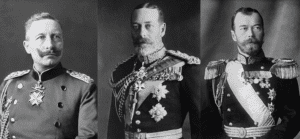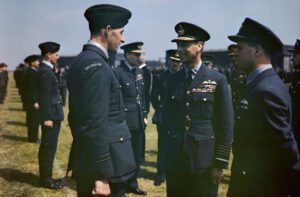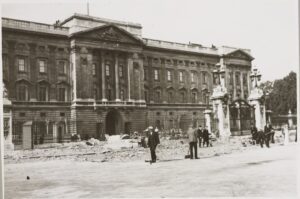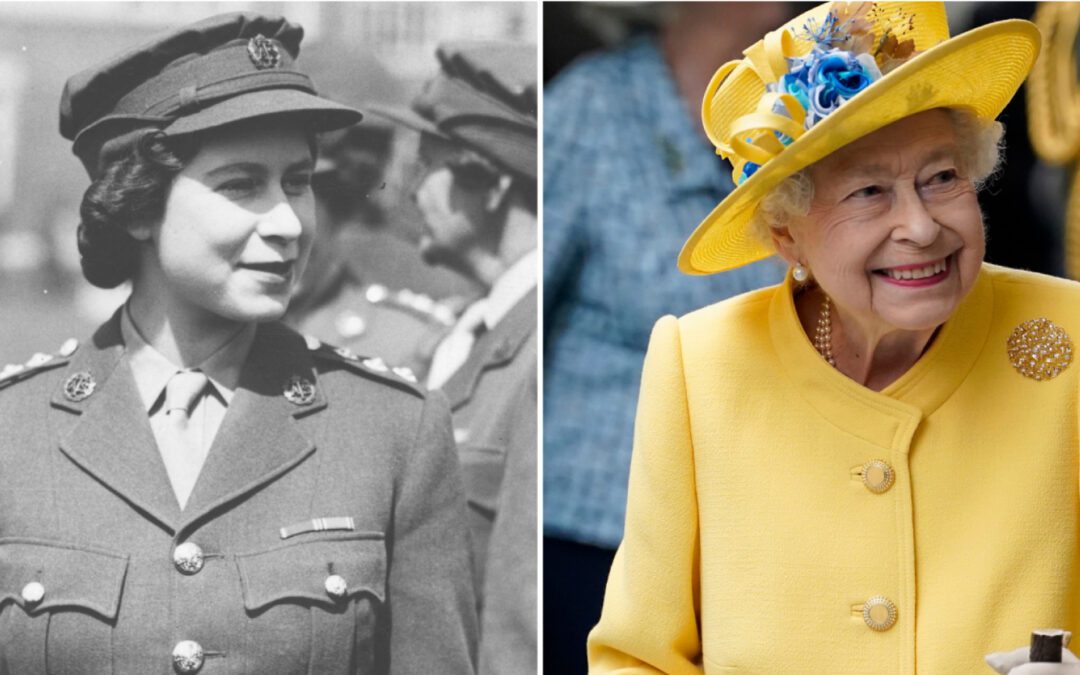In today’s #ForgottenFriday we are looking at the major influence and inspiration that the Royals throughout the wars.
The Royal Family have been a constant throughout the troubles that the nation and wider commonwealth have experienced over the years, whether that is a world war, economic crisis or pandemic.
We are looking closer at some of the key decisions and actions that the Royal Family took throughout the wars and how they selflessly supported a nation in turmoil.
WW1
At the outbreak of the First World War the Royal Family was led by George himself and his wife Queen Mary (she had originally been named Victoria Mary but had dropped the first name out of respect for George’s grandmother). The pair also had six children; Edward (who would later become Edward VIII before his abdication), Albert (who would then become George VI), Mary, Henry, George and the youngest John.

King George V and Queen Mary were both active in supporting soldiers during the war years and visited the Western Front numerous times and also paid repeated visits to hospitals of wounded soldiers. During one visit to France George suffered a broken pelvis when his horse rolled over on top of him.
Edward, the heir to the throne, was keen on serving in the military immediately when war was declared. However, his hopes of fighting on the Western Front were dashed when Lord Kitchener, the Secretary of War, refused to allow the British heir to place himself in such danger. Despite this Edward would pay many visits to the front line trenches and witness the fighting at first hand. Albert served in the navy during the war and was mentioned in dispatches for his work as a turret officer during the Battle of Jutland. However, ill health would shortly rule him out of military service.
Princess Mary became heavily involved with supporting soldiers in action through the creation of the Princess Mary Christmas Tins and those who were wounded and then treated in military hospitals back in Britain.
Changing the Name
As the war continued it became increasingly clear that the Germanic links of the Royal name Saxe-Coburg and Gotha were proving unpopular. Elsewhere in Europe the revolution to overthrow George’s cousin Nicholas in Russia caused wider concern about the future of European monarchies. It was for this reason that George himself had blocked any attempts to offer an escape for Nicholas and his family in Britain. George also took the step of suspending or revoking the British peerages and titles of his relatives who were fighting on the German side.

In order to ensure that the Royal Family continued to be viewed as British a Royal Proclamation was issued on 17 July 1917 announcing a new Royal name:
Now, therefore, We, out of Our Royal Will and Authority, do hereby declare and announce that as from the date of this Our Royal Proclamation Our House and Family shall be styled and known as the House and Family of Windsor, and that all the descendants in the male line of Our said Grandmother Queen Victoria who are subjects of these Realms, other than female descendants who may marry or may have married, shall bear the said Name of Windsor….
By anglicising the Royal household and other notable estates and titles, George V permanently changed the appearance of the monarchy in a move that endures to this day.
WW2
At 6pm on 3 September 1939, King George VI spoke to the people of Britain and the Empire. In his radio broadcast, he talked of the difficult times ahead and urged his people to stand firm.
The King held the ranks of Admiral of the Fleet, Field Marshal and Marshal of the Royal Air Force (RAF). He and Queen Elizabeth inspected troops and visited work places. On these occasions the King always appeared in uniform.

During a Royal Visit to the Leyland Factory in 1941, the King and Queen took a real interest in the work that people were doing. This raised morale and gave factory workers a renewed enthusiasm for their work. The Ministry of Supply studied the effects of royal visits and found that, in most cases, production figures dropped on the day of the visit but the weekly production figures invariably rose.
The Blitz
On the 8th of September 1940, the Luftwaffe dropped a 50-kilogram bomb landed on the grounds of Buckingham Palace. Placed in central London, the Palace had been a suspected target for the Luftwaffe’s campaign for some time, but just five days later, five bombs shook the castle. The King and Queen, drinking tea at the time, were unharmed by the blast, but the event would go on to bolster the community spirit and raise the morale of those who couldn’t flee the capital to the countryside. Elizabeth stated that she felt she could ‘face the public now’ after the attack on the Palace.

Following the near miss, the Royal Family was advised to flee the country and seek safety somewhere further removed from the ongoing conflict. The Queen, however, refused to leave her husband’s side and insisted that the Princesses Elizabeth and Margaret remain with their family. The family remained in the UK, moving between palaces, throughout the duration of the war.

One month later, Elizabeth and her sister Margaret gave their first royal address as part of the BBC’s Children’s hour. They addressed the children of the commonwealth and evacuees; the princesses spoke about the importance of the support of the troops fighting overseas and doing whatever possible to ensure that they had the best chance of a safe return.
Stating that “We know, every one of us, that in the end all will be well; for God will care for us and give us victory and peace.”
At the age of only 14, Elizabeth was photographed picking up a spade and taking part in the Dig for Victory campaign. Complete with a Corgi in a wicker wheelbarrow, the image of the princesses doing their part for the war effort encouraged other families across the country to pitch in and take part in the Dig for Victory campaign. It posed a sense of regional support and morale, working together as a collective to feed the nation.

Princess Elizabeth (now Queen Elizabeth II, left) and her younger sister Princess Margaret Rose (1930 – 2002) working on their allotment in the grounds of Windsor Castle, 11th August 1943. They are taking part in the government’s ‘Dig For Victory’ campaign. (Photo by Topical Press Agency/Hulton Archive/Getty Images)
With increased rationing and restrictions on food and the need for all storage space available for ammunition, families across the UK were encouraged to pick up spades and dig up their gardens, local parks, and any other green spaces to grow food and keep livestock.
The ATS
As the war progressed, Elizabeth became increasingly eager to get involved and do her part to show support. Much to the reluctance of the King, Elizabeth signed up to the Auxiliary Territorial Service (ATS) shortly after she turned 18.
The ATS was the women’s branch of the British Army during the Second World War. Initially, a voluntary service, the ATS started conscripting unmarried women under the age of 30 to work in agriculture and industry to stop the gap and compensate for the labour shortages across Britain. Based out of a training camp in Camberly, Surrey, Elizabeth trained as a mechanic and driver for the Second Subaltern Windsor Unit.
Elizabeth continued to lead by example to raise morale and inspiration in post-war Britain. Still gripped with shortages in food, labour Britain was living in a time of extreme austerity. The Royal Family was not exempt from the measures that restricted food and clothing. In 1947, Elizabeth dutifully saved her clothing ration coupons to pay for her own wedding dress. With a 200-coupon supplement from the government, Elizabeth’s dress took 350 women seven weeks to create and cost £30,000. For one photography sitting with Royal Photographer Cecil Beaton, in the spirit of “make do and mend”, the Princess Elizabeth wore a dress recycled from one of her mother’s pre-war evening gowns.
Members of the public were so excited and even sent their own clothing coupons to the Princess to help cover the costs; however, as it was illegal to transfer ownership of the coupons, each donation was sent back to the original owner with a thank you letter.
Thank you to you, Your Majesty, and your family. You will never be forgotten for your duty and honour to serve.


